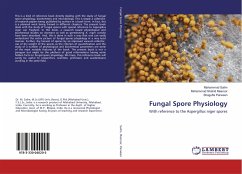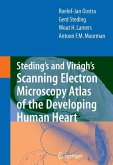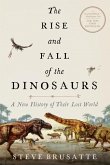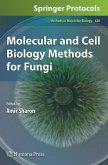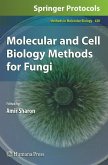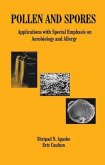Alice F. Tryon, Bernard Lugardon
Spores of the Pteridophyta
Surface, Wall Structure, and Diversity Based on Electron Microscope Studies
Alice F. Tryon, Bernard Lugardon
Spores of the Pteridophyta
Surface, Wall Structure, and Diversity Based on Electron Microscope Studies
- Broschiertes Buch
- Merkliste
- Auf die Merkliste
- Bewerten Bewerten
- Teilen
- Produkt teilen
- Produkterinnerung
- Produkterinnerung
Pteridophyte spores, the main agent of dispersal carrying the essential genet ic material for sexual reproduction of plants and persistence of the species, are single, airborne cells with complex walls. Palynological records of these spores supply stratigraphic data and evidence of early diversification of vas cular plants, as well as testimony of climatic and vegetational changes. Compared to the extensive work on pollen, there are relatively few mod ern studies on development and structure of pteridophyte spore walls. This survey provides a source of original information on these spores,…mehr
Andere Kunden interessierten sich auch für
![Fungal Spore Physiology Fungal Spore Physiology]() Mohammad SalimFungal Spore Physiology27,99 €
Mohammad SalimFungal Spore Physiology27,99 €![Steding's and Virágh's Scanning Electron Microscopy Atlas of the Developing Human Heart Steding's and Virágh's Scanning Electron Microscopy Atlas of the Developing Human Heart]() Roelof-Jan OostraSteding's and Virágh's Scanning Electron Microscopy Atlas of the Developing Human Heart112,99 €
Roelof-Jan OostraSteding's and Virágh's Scanning Electron Microscopy Atlas of the Developing Human Heart112,99 €![The Rise and Fall of the Dinosaurs The Rise and Fall of the Dinosaurs]() Steve BrusatteThe Rise and Fall of the Dinosaurs17,21 €
Steve BrusatteThe Rise and Fall of the Dinosaurs17,21 €![Molecular and Cell Biology Methods for Fungi Molecular and Cell Biology Methods for Fungi]() Molecular and Cell Biology Methods for Fungi112,99 €
Molecular and Cell Biology Methods for Fungi112,99 €![Molecular and Cell Biology Methods for Fungi Molecular and Cell Biology Methods for Fungi]() Molecular and Cell Biology Methods for Fungi82,99 €
Molecular and Cell Biology Methods for Fungi82,99 €![Pollen and Spores Pollen and Spores]() S N AgashePollen and Spores160,99 €
S N AgashePollen and Spores160,99 €![Development of Order in the Visual System Development of Order in the Visual System]() Development of Order in the Visual System77,99 €
Development of Order in the Visual System77,99 €-
-
-
Pteridophyte spores, the main agent of dispersal carrying the essential genet ic material for sexual reproduction of plants and persistence of the species, are single, airborne cells with complex walls. Palynological records of these spores supply stratigraphic data and evidence of early diversification of vas cular plants, as well as testimony of climatic and vegetational changes. Compared to the extensive work on pollen, there are relatively few mod ern studies on development and structure of pteridophyte spore walls. This survey provides a source of original information on these spores, pertinent descriptive characteristics, and related commentary. Studies of sporogenesis and ultrastructure utilizing the electron microscopes have greatly contributed to our knowledge of the development, structure, and variation of spore walls of the Pteridophyta. The synopsis of wall development and structure in the introductory section-New Concepts on Sporoderm Development and Ultra structure-supplies a comparative review of spores in the Pteridophyta. Source of Material Studied The spores are largely from collections in the Harvard University Herbarium (Gray Herbarium and Arnold Arboretum), except as indicated in the cap tions. We are grateful to the directors and curators of these and the follow ing institutions for permission to examine specimens included in the work: Herbarium ]utlandicum, Botanical Institute, University of Aarhus, Den mark; Queensland Regional Station, C. S. I. R. O.
Produktdetails
- Produktdetails
- Verlag: Springer, Berlin
- Softcover reprint of the original 1st ed. 1991
- Seitenzahl: 664
- Erscheinungstermin: 16. Dezember 2011
- Englisch
- Abmessung: 280mm x 210mm x 36mm
- Gewicht: 1595g
- ISBN-13: 9781461389934
- ISBN-10: 1461389933
- Artikelnr.: 36117426
- Herstellerkennzeichnung
- Springer Nature c/o IBS
- Benzstrasse 21
- 48619 Heek
- Tanja.Keller@springer.com
- Verlag: Springer, Berlin
- Softcover reprint of the original 1st ed. 1991
- Seitenzahl: 664
- Erscheinungstermin: 16. Dezember 2011
- Englisch
- Abmessung: 280mm x 210mm x 36mm
- Gewicht: 1595g
- ISBN-13: 9781461389934
- ISBN-10: 1461389933
- Artikelnr.: 36117426
- Herstellerkennzeichnung
- Springer Nature c/o IBS
- Benzstrasse 21
- 48619 Heek
- Tanja.Keller@springer.com
1.Ophioglossaceae.- 1. Botrychium.- 2. Helminthostachys.- 3. Ophioglossum.- 2.Marattiaceae.- 4. Angiopteris.- 5. Protomarattia.- 6. Christensenia.- 7. Archangiopteris.- 8. Marattia.- 9. Danaea.- 3.Osmundaceae.- 10. Osmunda.- 11. Todea.- 12. Leptopteris.- 4.Gleicheniaceae.- 13. Gleichenia.- 14. Dicranopteris.- 15. Stromatopteris.- 5.Matoniaceae.- 16. Matonia.- 17. Phanerosorus.- 6.Cheiropleuriaceae.- 18. Cheiropleuria.- 7.Dipteridaceae.- 19. Dipteris.- 8.Hymenophyllaceae.- 20. Hymenoglossum.- 21. Serpyllopsis.- 22. Hymenophyllum.- 23. Sphaerocionium.- 24. Crepidomanes.- 25. Trichomanes.- 26. Cephalomanes.- 27. Cardiomanes.- 9.Schizaeaceae.- 28. Lygodium.- 29. Anemia.- 30. Mohria.- 31. Schizaea.- 10.Pteridaceae.- 32. Platyzoma.- 33. Ceratopteris.- 34. Pityrogramma.- 35. Anogramma.- 36. Eriosorus.- 37. Jamesonia.- 38. Pterozonium.- 39. Nephopteris.- 40. Cerosora.- 41. Afropteris.- 42. Onychium.- 43. Actiniopteris.- 44. Austrogramme.- 45. Syngramma.- 46. Taenitis.- 47. Cheilanthes.- 48. Adiantopsis.- 49. Notholaena.- 50. ?ellaea.- 51. Doryopteris.- 52. Paraceterach.- 53. Bommeria.- 54. Hemionitis.- 55. Trachypteris.- 56. Coniogramme.- 57. Cryptogramma.- 58. Llavea.- 59. Adiantum.- 60. Ochropteris.- 61. Anopteris.- 62. Pteris.- 63. Idiopteris.- 64. Neurocallis.- 65. Acrostichum.- 11.Vittariaceae.- 66. Rheopteris.- 67. Antrophyum.- 68. Anetium.- 69. Vittria.- 70. Monogramma.- 71. Hecistopteris.- 12.Loxomataceae.- 72. Loxoma.- 73. Loxsomopsis.- 13.Plagiogyriaceae.- 74. Plagiogyria.- 14.Dicksoniaceae.- 75. ?ulcita.- 76. Calochlaena.- 77. Cibotium.- 78. Cystodium.- 79. Thyrsopteris.- 80. Dicksonia.- 15.Hymenophyllopsidaceae.- 81. Hymenophyllopsis.- 16.Metaxyaceae.- 82. Metaxya.- 17.Lophosoriaceae.- 83. Lophosoria.- 18.Cyatheaceae.- 84. Sphaeropteris.- 85. Alsophila.- 86.Nephelea.- 87. Trichipteris.- 88. Cyathea.- 89. Cnemidaria.- 19.Dennstaedtiaceae.- 90. Saccoloma.- 91. Dennstaedtia.- 92. Oenotrichia.- 93. Leptolepia.- 94. Monachosorum.- 95. Microlepia.- 96. Pteridium.- 97. Paesia.- 98. Hypolepis.- 99. Blotiella.- 100. Histiopteris.- 101. Lonchitis.- 102. Odontosoria.- 103. Tapeinidium.- 104. Xyropteris.- 105. Lindsaea.- 106. Ormoloma.- 20.Polypodiaceae.- 107. Platycerium.- 108. Pyrrosia.- 109. Aglaomorpha.- 110. Drynaria.- 111. Belvisia.- 112. Drymotaenium.- 113. Lemmaphyllum.- 114. Lepisorus.- 115. Christiopteris.- 116. Colysis.- 117. Dictymia.- 118. Lecanopteris.- 119. Leptochilus.- 120. Microsomia.- 121. Neocheiropteris.- 122. Phymatosorus.- 123. Campyloneurum.- 124. Dicranoglossum.- 125. Microgramma.- 126. Neurodium.- 127. Niphidium.- 128. Pleopeltis.- 129. Polypodiopteris.- 130. Marginariopsis.- 131. Polypodium.- 132. Goniophlebium.- 133. Solanopteris.- 134. Arthromeris.- 135. Selliguea.- 136. Anarthropteris.- 137. Loxogramme.- 21.Grammitidaceae.- 138. Grammitis.- 139. Calymmodon.- 140. Acrosorus.- 141. Scleroglossum.- 142. Pleurosoriopsis.- 22.Davalliaceae.- 143. Leucostegia.- 144. Davallodes.- 145. Araiostegia.- 146. Davallia.- 147. Gymnogrammitis.- 148. Nephrolepis.- 23.Thelypteridaceae.- 149. Thelypteris.- 150. Phegopteris.- 151. Pseudophegopteris.- 152. Macrothelypteris.- 153. Cyclosorus.- 24.Dryopteridaceae.- 154. Rumohra.- 155. Acrophorus.- 156. Peranema.- 157. Stenolepia.- 158. Nothoperanema.- 159. Dryopteris.- 160. Arachniodes.- 161. Lithostegia.- 162. Maxonia.- 163. Polystichum.- 164. Cyrtomium.- 165. Didymochlaena.- 166. Stigmatopteris.- 167. Cyclodium.- 168. Polybotrya.- 169. Tectaria.- 170. Heterogonium.- 171. Pleocnemia.- 172. Hypoderris.- 173. Psomiocarpa.- 174. Triplophyllum.- 175. Ctenitis.- 176. Megalastrum.-177. Aenigmopteris.- 178. Dryopsis.- 179. Lastreopsis.- 180. Dryopolystichum.- 181. Pteridrys.- 182. Cyclopeltis.- 183. Adenoderris.- 184. Athyrium.- 185. Diplazium.- 186. Hemidictyum.- 187. Deparia.- 188. Cornopteris.- 189. Cystopteris.- 190. Gymnocarpium.- 191. Hypodematium.- 192. Woodsia.- 193. Onocleopsis.- 194. Matteuccia.- 195. Onoclea.- 25.Oleandraceae.- 196. Oleandra.- 197. Arthropteris.- 26.Lomariopsidaceae.- 198. Lomariopsis.- 199. Teratophyllum.- 200. Lomagramma.- 201. Bolbitis.- 202. Elaphoglossum.- 27.Blechnaceae.- 203. Woodwardia.- 204. Pteridoblechnum.- 205. Steenisioblechnum.- 206. Doodia.- 207. Blechnum.- 208. Salpichlaena.- 209. Sadleria.- 210. Brainea.- 211. Stenochlaena.- 28.Aspleniaceae.- 212. Asplenium.- 213. Camptosorus.- 214. Ceterach.- 215. Schaffneria.- 216. Pleurosorus.- 217. Holodictyum.- 218. Diellia.- 29.Psilotaceae.- 219. Tmesipteris.- 220. Psilotum.- 30.Marsileaceae.- 221. Marsilea.- 222. Regnellidium.- 223. Pilularia.- 31.Salviniaceae.- 224. Salvinia.- 225. Azolla.- 32.Equisetaceae.- 226. Equisetum.- 33.Lycopodiaceae.- 227. Huperzia.- 228. Phylloglossum.- 229. Lycopodium.- 230. Lycopodiella.- 34.Selaginellaceae.- 231. Selaginella.- 35.Isoetaceae.- 232. Isoetes.- Terminology.
1.Ophioglossaceae.- 1. Botrychium.- 2. Helminthostachys.- 3. Ophioglossum.- 2.Marattiaceae.- 4. Angiopteris.- 5. Protomarattia.- 6. Christensenia.- 7. Archangiopteris.- 8. Marattia.- 9. Danaea.- 3.Osmundaceae.- 10. Osmunda.- 11. Todea.- 12. Leptopteris.- 4.Gleicheniaceae.- 13. Gleichenia.- 14. Dicranopteris.- 15. Stromatopteris.- 5.Matoniaceae.- 16. Matonia.- 17. Phanerosorus.- 6.Cheiropleuriaceae.- 18. Cheiropleuria.- 7.Dipteridaceae.- 19. Dipteris.- 8.Hymenophyllaceae.- 20. Hymenoglossum.- 21. Serpyllopsis.- 22. Hymenophyllum.- 23. Sphaerocionium.- 24. Crepidomanes.- 25. Trichomanes.- 26. Cephalomanes.- 27. Cardiomanes.- 9.Schizaeaceae.- 28. Lygodium.- 29. Anemia.- 30. Mohria.- 31. Schizaea.- 10.Pteridaceae.- 32. Platyzoma.- 33. Ceratopteris.- 34. Pityrogramma.- 35. Anogramma.- 36. Eriosorus.- 37. Jamesonia.- 38. Pterozonium.- 39. Nephopteris.- 40. Cerosora.- 41. Afropteris.- 42. Onychium.- 43. Actiniopteris.- 44. Austrogramme.- 45. Syngramma.- 46. Taenitis.- 47. Cheilanthes.- 48. Adiantopsis.- 49. Notholaena.- 50. ?ellaea.- 51. Doryopteris.- 52. Paraceterach.- 53. Bommeria.- 54. Hemionitis.- 55. Trachypteris.- 56. Coniogramme.- 57. Cryptogramma.- 58. Llavea.- 59. Adiantum.- 60. Ochropteris.- 61. Anopteris.- 62. Pteris.- 63. Idiopteris.- 64. Neurocallis.- 65. Acrostichum.- 11.Vittariaceae.- 66. Rheopteris.- 67. Antrophyum.- 68. Anetium.- 69. Vittria.- 70. Monogramma.- 71. Hecistopteris.- 12.Loxomataceae.- 72. Loxoma.- 73. Loxsomopsis.- 13.Plagiogyriaceae.- 74. Plagiogyria.- 14.Dicksoniaceae.- 75. ?ulcita.- 76. Calochlaena.- 77. Cibotium.- 78. Cystodium.- 79. Thyrsopteris.- 80. Dicksonia.- 15.Hymenophyllopsidaceae.- 81. Hymenophyllopsis.- 16.Metaxyaceae.- 82. Metaxya.- 17.Lophosoriaceae.- 83. Lophosoria.- 18.Cyatheaceae.- 84. Sphaeropteris.- 85. Alsophila.- 86.Nephelea.- 87. Trichipteris.- 88. Cyathea.- 89. Cnemidaria.- 19.Dennstaedtiaceae.- 90. Saccoloma.- 91. Dennstaedtia.- 92. Oenotrichia.- 93. Leptolepia.- 94. Monachosorum.- 95. Microlepia.- 96. Pteridium.- 97. Paesia.- 98. Hypolepis.- 99. Blotiella.- 100. Histiopteris.- 101. Lonchitis.- 102. Odontosoria.- 103. Tapeinidium.- 104. Xyropteris.- 105. Lindsaea.- 106. Ormoloma.- 20.Polypodiaceae.- 107. Platycerium.- 108. Pyrrosia.- 109. Aglaomorpha.- 110. Drynaria.- 111. Belvisia.- 112. Drymotaenium.- 113. Lemmaphyllum.- 114. Lepisorus.- 115. Christiopteris.- 116. Colysis.- 117. Dictymia.- 118. Lecanopteris.- 119. Leptochilus.- 120. Microsomia.- 121. Neocheiropteris.- 122. Phymatosorus.- 123. Campyloneurum.- 124. Dicranoglossum.- 125. Microgramma.- 126. Neurodium.- 127. Niphidium.- 128. Pleopeltis.- 129. Polypodiopteris.- 130. Marginariopsis.- 131. Polypodium.- 132. Goniophlebium.- 133. Solanopteris.- 134. Arthromeris.- 135. Selliguea.- 136. Anarthropteris.- 137. Loxogramme.- 21.Grammitidaceae.- 138. Grammitis.- 139. Calymmodon.- 140. Acrosorus.- 141. Scleroglossum.- 142. Pleurosoriopsis.- 22.Davalliaceae.- 143. Leucostegia.- 144. Davallodes.- 145. Araiostegia.- 146. Davallia.- 147. Gymnogrammitis.- 148. Nephrolepis.- 23.Thelypteridaceae.- 149. Thelypteris.- 150. Phegopteris.- 151. Pseudophegopteris.- 152. Macrothelypteris.- 153. Cyclosorus.- 24.Dryopteridaceae.- 154. Rumohra.- 155. Acrophorus.- 156. Peranema.- 157. Stenolepia.- 158. Nothoperanema.- 159. Dryopteris.- 160. Arachniodes.- 161. Lithostegia.- 162. Maxonia.- 163. Polystichum.- 164. Cyrtomium.- 165. Didymochlaena.- 166. Stigmatopteris.- 167. Cyclodium.- 168. Polybotrya.- 169. Tectaria.- 170. Heterogonium.- 171. Pleocnemia.- 172. Hypoderris.- 173. Psomiocarpa.- 174. Triplophyllum.- 175. Ctenitis.- 176. Megalastrum.-177. Aenigmopteris.- 178. Dryopsis.- 179. Lastreopsis.- 180. Dryopolystichum.- 181. Pteridrys.- 182. Cyclopeltis.- 183. Adenoderris.- 184. Athyrium.- 185. Diplazium.- 186. Hemidictyum.- 187. Deparia.- 188. Cornopteris.- 189. Cystopteris.- 190. Gymnocarpium.- 191. Hypodematium.- 192. Woodsia.- 193. Onocleopsis.- 194. Matteuccia.- 195. Onoclea.- 25.Oleandraceae.- 196. Oleandra.- 197. Arthropteris.- 26.Lomariopsidaceae.- 198. Lomariopsis.- 199. Teratophyllum.- 200. Lomagramma.- 201. Bolbitis.- 202. Elaphoglossum.- 27.Blechnaceae.- 203. Woodwardia.- 204. Pteridoblechnum.- 205. Steenisioblechnum.- 206. Doodia.- 207. Blechnum.- 208. Salpichlaena.- 209. Sadleria.- 210. Brainea.- 211. Stenochlaena.- 28.Aspleniaceae.- 212. Asplenium.- 213. Camptosorus.- 214. Ceterach.- 215. Schaffneria.- 216. Pleurosorus.- 217. Holodictyum.- 218. Diellia.- 29.Psilotaceae.- 219. Tmesipteris.- 220. Psilotum.- 30.Marsileaceae.- 221. Marsilea.- 222. Regnellidium.- 223. Pilularia.- 31.Salviniaceae.- 224. Salvinia.- 225. Azolla.- 32.Equisetaceae.- 226. Equisetum.- 33.Lycopodiaceae.- 227. Huperzia.- 228. Phylloglossum.- 229. Lycopodium.- 230. Lycopodiella.- 34.Selaginellaceae.- 231. Selaginella.- 35.Isoetaceae.- 232. Isoetes.- Terminology.


